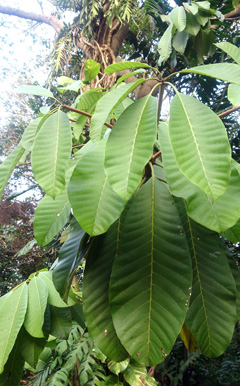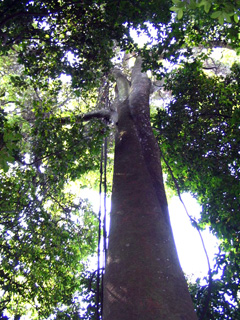 |
|
https://edibleplants.org/ |
 |
| https://edibleplants.org/ |
Translate this page:
Summary
Hill Jelutong (Dyera costulata) is a large, deciduous tree with a spreading crown that grows up to 75 m in height. The trunk is not buttressed and can be up to 3 m in diameter and up to 30 m unbranched. It can be found in Southeast Asia where it has long been exploited for timber and latex. The latex is used for chewing gum, celluloid, linoleum, insulation of electric cables, cement, paints, paper, etc. The resinous fruits are used as torches and as mosquito repellent. The roots are used as cork substitute. The wood, on the other hand, are used for carving, pencils, matches, veneer, etc.
Physical Characteristics

 Dyera costulata is a deciduous Tree growing to 50 m (164ft) by 30 m (98ft) at a medium rate.
Dyera costulata is a deciduous Tree growing to 50 m (164ft) by 30 m (98ft) at a medium rate.
See above for USDA hardiness. It is hardy to UK zone 10.
Suitable for: light (sandy), medium (loamy) and heavy (clay) soils and prefers well-drained soil. Suitable pH: mildly acid, neutral and basic (mildly alkaline) soils. It cannot grow in the shade. It prefers moist soil.
UK Hardiness Map
US Hardiness Map
Synonyms
Alstonia costulata Miq. Alstonia eximia Miq. Alstonia grandifolia Miq. Dyera laxiflora Hook.f.
Plant Habitats
Edible Uses
References More on Edible Uses
Medicinal Uses
Plants For A Future can not take any responsibility for any adverse effects from the use of plants. Always seek advice from a professional before using a plant medicinally.
Miscellany
The resinous fruits are used for medicinal purposes[ 317 ].
References More on Medicinal Uses
The Bookshop: Edible Plant Books
Our Latest books on Perennial Plants For Food Forests and Permaculture Gardens in paperback or digital formats.

Edible Tropical Plants
Food Forest Plants for Hotter Conditions: 250+ Plants For Tropical Food Forests & Permaculture Gardens.
More

Edible Temperate Plants
Plants for Your Food Forest: 500 Plants for Temperate Food Forests & Permaculture Gardens.
More

More Books
PFAF have eight books available in paperback and digital formats. Browse the shop for more information.
Shop Now
Other Uses
Containers Cork Furniture Latex Lighting Miscellany Repellent Wood
Other Uses: The latex, obtained by tapping the trunk, is used for the production of chewing gum, celluloid, linoleum and the insulation of electric cables[ 317 ]. Beside this it serves as admixture for cement, paints and paper[ 317 ]. The latex has a number of speciality uses such as pattern making in foundry work, for drawing boards, pencils, picture frames, dowels, carving, blackboards, wooden toys, clogs, brush handles and battery separators, and it is also used for furniture parts, door knobs, ceilings, partitioning, matchsticks, matchboxes and packing cases[ 349 ]. The resinous fruits serve as torches[ 317 ]. They are also burnt to repel mosquitoes[ 349 ]. The roots are used as a substitute for cork[ 325 , 349 ]. The heartwood is creamy white to pale straw coloured with the frequent presence of large latex canals; it is not differentiated from the sapwood. The grain is mostly straight; texture moderately fine and even; slightly lustrous; without taste but with a slight sour odour that is distinctive. The wood is very light in weight; soft; it is not durable, being susceptible to fungi, dry wood borers and termites. It seasons rapidly with only a slight risk of checking or distortion; once dry it is stable in service. The wood works easily with hand and machine tools, but they need to be kept very sharp in order to obtain a smooth finish; latex in the wood may clog the sawteeth; nailing and screwing are poor; gluing is correct. The wood is excellent for carving and is also used, among other things, for making patterns, pencils, matches, match-boxes, boxes and crates, furniture components, interior joinery and panelling, drawing boards, blockboard and veneer[ 316 , 317 , 848 ].
Special Uses
Carbon Farming
References More on Other Uses
Cultivation details
Industrial Crop: Hydrocarbon Management: Standard Regional Crop
A plant of the wet, lowland tropics, where it is usually found at elevations up to 400 metres, exceptionally to 800 metres[ 325 , 359 ]. Requires a sunny position - the tree develops a wide crown when growing in the sun in order to 'claim' its territory[ 325 ]. Prefers a well-drained soil, often growing on hills and ridges in the wild[ 325 ].
Carbon Farming
-
Industrial Crop: Hydrocarbon
Materials, chemicals and energy include bioplastics, rubber, biomass products gasoline, jet fuel, diesel, butane, propane, biogas. Plants are usually resprouting plants and saps.
-
Management: Standard
Plants grow to their standard height. Harvest fruit, seeds, or other products. Non-Destructive management systems.
-
Regional Crop
These crops have been domesticated and cultivated regionally but have not been adopted elsewhere and are typically not traded globally, Examples in this broad category include perennial cottons and many nuts and staple fruits.
References Carbon Farming Information and Carbon Sequestration Information
Temperature Converter
Type a value in the Celsius field to convert the value to Fahrenheit:
Fahrenheit:
The PFAF Bookshop
Plants For A Future have a number of books available in paperback and digital form. Book titles include Edible Plants, Edible Perennials, Edible Trees,Edible Shrubs, Woodland Gardening, and Temperate Food Forest Plants. Our new book is Food Forest Plants For Hotter Conditions (Tropical and Sub-Tropical).
Shop Now
Plant Propagation
Seed - the small seed has a limited viability of less than a year. Pre-treatment is not necessary, but soaking the seed in water for 12 hours prior to sowing can speed up the germination process[ 325 ]. Germination rates are usually good, with 80 - 90% of the seeds sprouting. Seedlings can be potted up when the first pair of leaves has emerged and planted out when 30cm tall.
Other Names
If available other names are mentioned here
Pantung, jelutong.
Native Range
TROPICAL ASIA: Thailand (south), Indonesia (Kalimantan, Sumatera), Malaysia, Singapore
Weed Potential
Right plant wrong place. We are currently updating this section.
Please note that a plant may be invasive in one area but may not in your area so it's worth checking.
Conservation Status
IUCN Red List of Threatened Plants Status : Status: Lower Risk/least concern

Growth: S = slow M = medium F = fast. Soil: L = light (sandy) M = medium H = heavy (clay). pH: A = acid N = neutral B = basic (alkaline). Shade: F = full shade S = semi-shade N = no shade. Moisture: D = dry M = Moist We = wet Wa = water.
Now available:
Food Forest Plants for Mediterranean Conditions
350+ Perennial Plants For Mediterranean and Drier Food Forests and Permaculture Gardens.
[Paperback and eBook]
This is the third in Plants For A Future's series of plant guides for food forests tailored to
specific climate zones. Following volumes on temperate and tropical ecosystems, this book focuses
on species suited to Mediterranean conditions—regions with hot, dry summers and cool, wet winters,
often facing the added challenge of climate change.
Read More
Expert comment
Author
(Miq.) Hook.f.
Botanical References
Links / References
For a list of references used on this page please go here
A special thanks to Ken Fern for some of the information used on this page.
Readers comment
| Add a comment |
|
If you have important information about this plant that may help other users please add a comment or link below. Only comments or links that are felt to be directly relevant to a plant will be included. If you think a comment/link or information contained on this page is inaccurate or misleading we would welcome your feedback at [email protected]. If you have questions about a plant please use the Forum on this website as we do not have the resources to answer questions ourselves.
* Please note: the comments by website users are not necessarily those held by PFAF and may give misleading or inaccurate information.
To leave a comment please Register or login here All comments need to be approved so will not appear immediately.
|
Subject : Dyera costulata
|
|
|
|